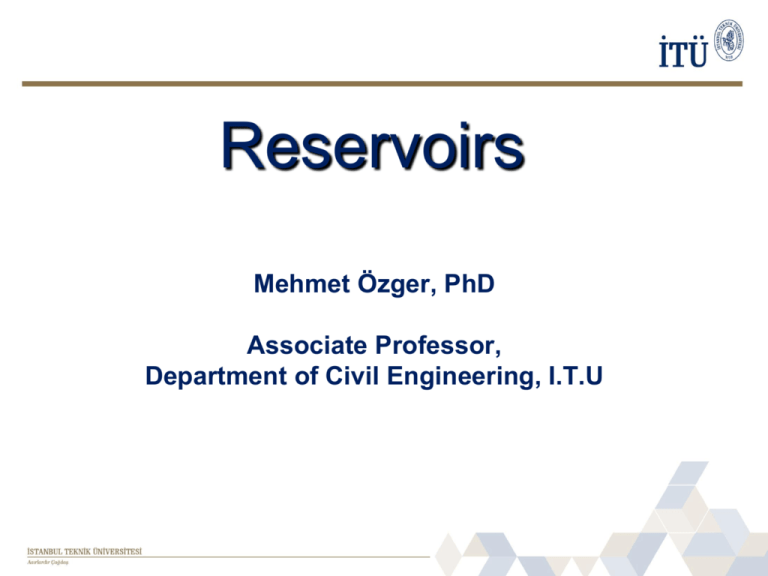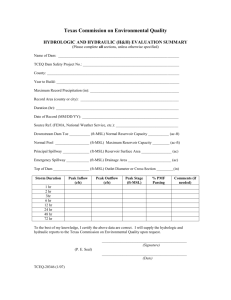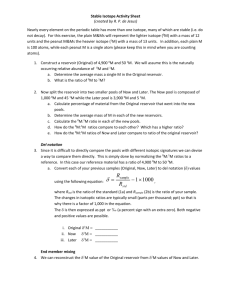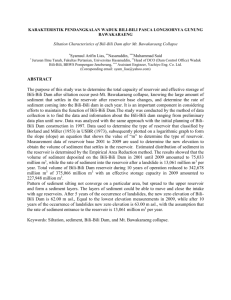Barajlar ve Baraj Hazneleri
advertisement

Reservoirs Mehmet Özger, PhD Associate Professor, Department of Civil Engineering, I.T.U A reservoirs has two categories: 1- Storage (conservation) [i.e., Atatürk dam] 2- Distribution (service) [for emergencies & fire fighting] Physical Characteristics of Reservoirs Primary function is to store Most important characteristic:“storage capacity” Reservoir: Collects water behind a dam or barrier Reservoirs are constructed for: Drinking water, Irrigation, Hydropower, Flood mitigation During a specified time interval; S (supply) < D (demand) Need for “water storage” Reservoir Spillway crest Upstream Dam body Spillway Downstream Elevation-Area-Volume Curves Area-elevation curve: is obtained by measuring the area enclosed within each contour in the reservoir site using a planimeter. Usually a 1/5000 scaled topographic map Elevation-storage curve: is the integration of an area-elevation curve. The storage between any two elevations can be obtained by the product of average surface area at two elevations multiplied by the difference in elevation. Elevation-Area-Volume Curves ELEVATION ABOVE MEAN SEA LEVEL (m) To determine reservoir volume with given location & dam height Max. Operating Level Spillway Crest Area Volume Minimum Operating Level Zero Pool VOLUME (106 m3) Typical reservoir elevation-area-volume curves Total reservoir storage components: a) Normal pool level b) Minimum pool level c) Active storage d) Dead storage e) Flood control storage f) Surcharge storage Storage zones in a reservoir Maximum pool level Surcharge storage Flood control storage Flow Retarding pool level Spillway crest Normal pool level Active storage or Useful storage Sluiceway Minimum pool level Dead storage Sediment accumulation Normal pool level is the maximum elevation to which the reservoir surface will rise for ordinary reservoir operations. Minimum pool level is the lowest allowable elevation to which the reservoir surface level can fall. Dead storage is located below minimum pool level. The top elevation is dictated by amount of sediment accumulation at the end of the life time of reservoir. Therefore, the elevation of the lowest sluiceway must be located at least at minimum pool level. Water stored below this level is not available for any use. The storage between minimum and normal pool levels is named as useful or active storage. The flood control storage occupies between the retarding and normal pool levels. The surcharge storage stays between retarding and maximum pool level. General guidelines for a reservoir location: Cost of the dam Cost of real estate Topographic conditions to store water Possibility of deep reservoir Avoiding from tributary areas Quality of stored water Reliable hill-slopes Reservoir Yield Yield: Amount of water that reservoir can deliver in a prescribed interval of time. The yield is based on inflow capacity Firm (safe) yield: Amount of water that can be supplied during a critical period. Can be never determined by certainty Target yield: specified for a reservoir based on the estimated demands in most cases. Secondary yield: Water available in excess of safe yield during high flow periods Selection of Capacity of a Storage Reservoir Designing the capacity of a storage reservoir involves with determination of the critical period during Inflow < Demand There are 4 approaches to determine the capacity 1) 2) 3) 4) Mass curve (Ripple diagram) method; Sequent-peak algorithm; Operation study; Optimization analysis 1) Mass curve (Ripple diagram) method Features of Mass Curve Cumulative plotting of net reservoir inflow. Slope of mass curve gives the value of inflow (S) at that time. Slope of demand curve gives the demand rate (D) or yield. Mass curve (Ripple diagram) method The difference between the lines (a+b) tangent to the demand line (∑D) drawn at the highest and lowest points (A and B, respectively) of mass curve (∑S) gives the rate of withdrawal from reservoir during that critical period. The maximum cumulative value between tangents is the required storage capacity (active storage). Mass curve method S,D b a D a+b t1 t t2 ∑S, ∑D ∑D A a t1 b a+b B ∑S t t2 Mass curve analysis 2) Sequent-Peak Analysis The mass curve approach is easy to use when short periods of data are to be analyzed. SPA is a modification of the Mass Curve analysis for lengthy time series and particularly suited to computer coding. The steps of sequent-peak analysis are as follows: Plot ∑ (Inflow-Withdrawal) : in symbolized fashion ∑(S-D) Sequent-peak Sequent-peak Sequent-peak Maximum storage ∑(FLOW-DEMAND) 1) Illustration of the sequent –peak algorithm Time 2) 3) 4) 5) Locate the initial peak and the next peak Compute the storage required which is the difference between the initial peak and the lowest trough in the interval, Repeat the process for all sequent peaks, Determine the largest value of storages as “STORAGE CAPACITY Analytical solution to SPA is good for computer coding Equations below are used: Vt = Dt – St + Vt-1 if positive Vt = 0 otherwise Vt : required storage capacity at the end of period t Vt-1 : required storage capacity at the end of previous period t Dt : release during period t St : inflow during period t 3) OPERATION STUDY It is presumed that the reservoir is adequate if the reservoir can supply all types of demands under possible losses such as seepage and evaporation. The operation study is based on the solution of the continuity equation. dV I Q dt Where dV is differential storage during time dt I and Q are the instantaneous total inflow outflow, respectively. is used to a) Determine the required capacity, b) Define the optimum rules for operation, c) Select the installed capacity for powerhouses, d) Make other decisions regarding to planning. is carried out 1) only for an extremely low flow period and presents the required capacity to overcome the selected drought; 2) for the entire period and presents the power production for each year. 4) OPTIMIZATION ANALYSIS & STOCHASTIC MODELS Reliability of Reservoir Yield Sediments eventually fill all reservoirs determine the useful life of reservoirs important factor in planning ■ River carry some suspended sediment and move bed load (larger solids along the bed). ■ Large suspended particles + bed loads deposited at the head of the reservoir & form delta. ■ Small particles suspend in the reservoir or flow over the dam. ■ Bed load ≈ 5 to 25 % of the suspended load in the plain rivers ≈ 50 % of the suspended load in the mountainous rivers ☻ Unfortunately, the total rate of sediment transport in Turkey > 18 times that in the whole Europe (500x106 tons/year) Sedimentation stored behind a dam “RESERVOIR SEDIMENTATION RATE” ▬ based on survey of existing reservoirs, containing * Specific weight of the settled sediments * % of entering sediment which is deposited “TRAP EFFICIENCY”: % of inflowing sediment retained in the reservoir ▬ function of the ratio of reservoir capacity to total inflow. IMPORTANT NOTES: ► “Prediction of sediment accumulation” -- Difficult due to high range of variability in sediment discharge ► SOLUTION: “Continuous hydrologic simulation models” -- used for prediction purposes < But, at least, 2-3 years daily data are needed for calibration of the model. > Relationship between discharge and sediment load Another formula for sediment load prediction Y= mean sediment yield in m3 A= drainage area in km2 IMPORTANT NOTES: ► “To control amount of entering sediment”: (a) Upstream sedimentation basins, (b) Vegetative screens, (c) Soil conservation methods (i.e., terraces), (d) Implementing sluice gates at various levels. (e) Dredging of settled materials, but not economical!







